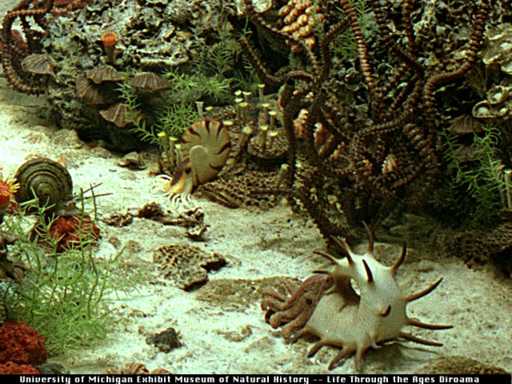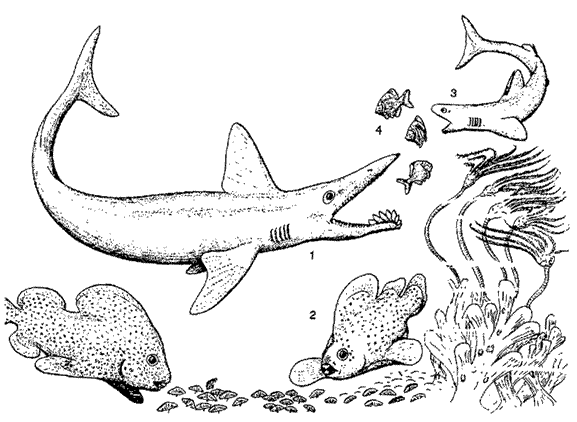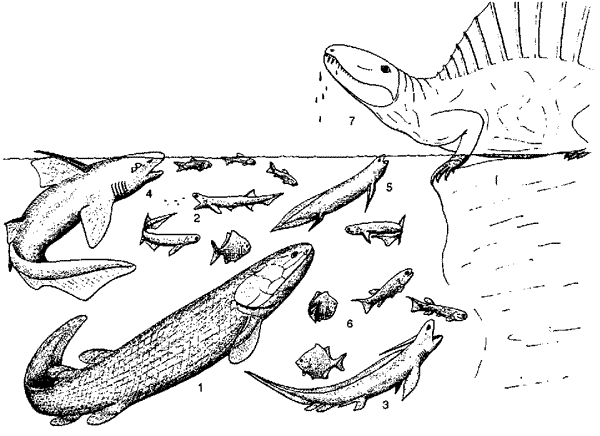| Cisuralian Epoch | ||
| Paleozoic: Permian Period |
Cisuralian |
| Pennsylvanian | Carboniferous | Permian | ||
| Guadalupian | Triassic | Asselian | Time |
| Paleozoic Permian Early Permian Cisuralian Epoch Asselian Sakmarian Artinskian Kungurian Middle Permian Guadalupian Epoch Late Permian Lopingian Epoch |

A Permian reef (Artinskian of Texas), showing an abundance of sponges, rugose corals and brachiopods, a gastropod (left)), a spiny-shelled nautilid Cooperoceras (right foreground) and a smooth shelled ammonoid (center background).
source - Earth History Resources
Early Permian fishes from the Copacabana Formation of Bolivia. The fauna still includes some of the peculiar chondrichthyans of the Carboniferous, such as huge engeneodontids (1. Parahelicoprion) and petalodontids (2, Megactenopetalus) along with primitive sharks (3) and a variety of ray-finned fishes (4, platysomids).

In the Early Permian, the last refuge for some of the vertebrate taxa that were widespread in Devonian times was the marginal, possibly brackish or freshwater, environment. exemplified here by the red beds of the Wichita Group of Texas. In this environment survived the youngest osteolepiform (1. Ectosteorhachis) and acanthodians (2. Acanthodes) in association with xenacanthiform (3) and hybodontiform sharks (4). as well as with coelacanths, lungfishes (5), and various ray-finned fishes (6). Various tetrapods stem tetrapods and early synapsids, 7) also occur together with this fish fauna
this and previous image and (most of) the associated text from Philippe Janvier's superb Early Vertebrates, pp.22-23 (Clarendon Press, Oxford, 1996).
The early Permian age, a period of well over 20 million years, was - as far as the terrestrial ecosystem went - a fairly stable period ruled over by a diverse selection of pelycosaurs, including the large sphenacodontid finbacks such as the carnivorous Dimetrodon, Ctenospondylus, and Secodontosaurus, all of which attained a lengths of up to 3 meters, as well as semi-aquatic ophiacodonts and the big temnospondyl Eryops and smaller eel-like anthracosaur Archeria. This was a biome strongly tied to water and to a plant-arthropod-fish food chain; Diadectes and Edaphosaurus were the only herbivores. In this respect it continued the pattern of the great Carboniferous coal swamps. The drier upland was inhabited by a different fauna, mostly smaller insectivores with the herbivorous caseids and proto-therapsid Tetraceratops as significant newcomers. Both in the uplands and the lowlands insects continued to represent an astonishing diversity of forms.
Click on the names of the stages given below for more detail regarding the stratigraphy and animals living at that time (note: these pages are still under construction)
| Period | Epoch | Age | When began |
Duration |
| Permian | Guadalupian (Middle Permain) |
Roadian | 270.6 | 2.6 |
| Cisuralian (early Permian) |
Kungurian | 275.6 | 5.0 | |
| Artinskian | 284.4 | 8.8 | ||
| Sakmarian | 294.6 | 10.2 | ||
| Asselian | 299.0 | 4.4 | ||
| Carboniferous | Pennsylvanian | Gzhelian | 303.9 | 4.9 |
The Permian - a brief but very readable introduction to some of the major animals and plants of early Permian time, with illustrations from the Age of Reptiles mural by Rudolph F. Zallinger
American Permian Vertebrates - an electronic reprint of Williston's classic (1911) monograph on American Permian Vertebrates (includes Eryops, Aspidosaurus, Nothodon, Seymouria, Clepsydrops, Ophiacodon, Varanosaurus, Casea, and others) can be purchased here for an inexpensive fee.